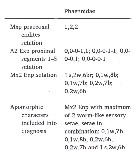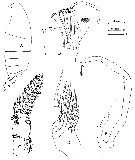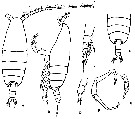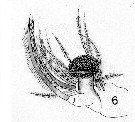|
|
 |
|
Calanoida ( Ordre ) |
|
|
|
Clausocalanoidea ( Superfamille ) |
|
|
| |
| | | |
| Phaennidae Sars, 1902 ( Clausocalanoidea ) | | Ref.: | Sars, 1902 (1903) (p.42); Gurney,1931 a (p.84); Rose, 1933 a (p.125); Brodsky, 1950 (1967) (p.83, 225); Bradford, 1969 b (p.502, Table 3); Mazza, 1967 (p.173); Bradford, 1973 (p.137, Def.); Andronov, 1974 a (p.1005); Bowman & Abele, 1982 (p.9); Razouls, 1982 (p.279); 1993 (p.310); Brodsky & al., 1983 (p.144,146); Park, 1983 a (p.317, Def.); Bradford & al., 1983 (p.58); Mauchline, 1988 (p.735, 740 : cuticular pores); Huys & Boxshall, 1991 (p.356); Chihara & Murano, 1997 (p.852); Bradford-Grieve & al., 1999 (p.880, 902, 904, 927, Key of Genera); Ohtsuka & Huys, 2001 (p.461); Ohtsuka & al., 2003 (p.53, 62: Rem.); Boxshall & Halsey, 2004 (p.15; 49; 158: Def.; p.160: Key of genera); Ferrari & Markhaseva, 2005 (p.45, Rem.); Markhaseva & Ferrari, 2005a (p.111, fig.31, Rem.); Vives & Shmeleva, 2007 (p.678, part. Genera Key); Blanco-Bercial & al., 2011 (p.103, Table 1, Fig.2, 3, 4, Biol. molecular phylogeny); Markhaseva & al., 2014 (p.63, 67, 73, 75, Table 1, 2, 3, 4, Rem., Def.) ; Laakmann & al., 2019 (p.330, Table 1, fig.1, 2, 3, Table A, phylogenetic relationships)
Bradford-Grieve J.M., (2002 onwards). Key to calanoid copepod families. Version 1 : 2 oct 2002. http://www.crustacea.net/crustace/calanoida/index.htm  | | Rem.: | 8 G + 1 G.: Brachycalanus, Cephalophanes, Cornucalanus, Onchocalanus, Phaenna, Phaennocalanus, Talacalanus, Xanthocalanus + Kirnesius..
Schulz (1998, p.42, 48), Vyshkvartzeva (2000, p.217) et Ohtsuka & al., 2003 (p.61, 62) considèrent le genre Xantharus comme appartenant à la famille des Scolecitrichidae. L'appartenance de ce genre à cette famille est discutée par Schulz & Kwasniewski (2004, p.158).
Markhaseva & Semenova (2005) incluent provisoirement le genre Kirnesius dans cette famille. |  Issued from : E.L. Markhaseva, S. Laakmann & J. Renz in Mar. Biodiv., 2014, 44 [p.70, Fig. 5]. Schematic view of right A1 in males of ''Bradfordian'' family Phaennidae. Black arrows: fused ancestral segments; Roman numerals: ancestral segments; dotted line between antennule segments: incomplete fusion. |
 Issued from : E.L. Markhaseva, S. Laakmann & J. Renz in Mar. Biodiv., 2014, 44 [p.73, Table 1]. A2 armament (number of seta) in different ''Bradfordian'' genera (females). Phaennidae. c: coxa; b: basis; End1: endopod segment 1; End2: endopod segment 2; Exp: exopod. |
 Issued from : E.L. Markhaseva, S. Laakmann & J. Renz in Mar. Biodiv., 2014, 44 [p.74, Table 2]. Md armament (number of seta) in different ''Bradfordian'' genera (females). Phaennidae. b: basis; End1: endopod segment 1; End2: endopod segment 2; Exp: exopod; gn: gnathobase. |
 Issued from : E.L. Markhaseva, S. Laakmann & J. Renz in Mar. Biodiv., 2014, 44 [p.76, Table 3]. Mx1 armament (number of seta) in different ''Bradfordian'' genera (females). Phaennidae. pa: praecoxal arthrite (setal formula of praecoxal arthrite: terminal+posterior+anterior setae); ce: coxal endite; bp: proximal basal endite; bd: distal basal endite; End: endopod; Exp: exopod; Epi: epipodite. |
 Issued from : E.L. Markhaseva, S. Laakmann & J. Renz in Mar. Biodiv., 2014, 44 [p.78, Table 4]. Mx2 armament (number of seta) in different ''Bradfordian'' genara (females). Phaennidae. at: attenuation; pe: praecoxal endite; ce: coxal endite; bp: proximal basal endite; bd: distal basal endite; el: enditic-like lobe of proximal endopodal segment; End: endopod; w: worm-like seta; br: brush-like seta; sc: sclerotised seta. |
 Issued from : E.L. Markhaseva, S. Laakmann & J. Renz in Mar. Biodiv., 2014, 44 [p.80, Table 5]. Mxp setation (number of seta) in different ''Bradfordian'' genera (females). Phaennidae. at: attenuation; pes: praecoxal endites of syncoxa (from proximal to distal); ces: coxal endite of syncoxa; bp: basis proximal; bd: basis distal; End: endopod. For more detailed morphology of the seta on the praecoxal endites of the maxilliped syncoxa see Markhaseva & Ferrari (2005) and Markhaseva & al. (2008). |
 Issued from : G.A. Boxshall & S.H. Halsey in An Introduction to Copepod Diversity. The Ray Society, 2004, No 166, Part. I. [p.158]. Armature formula of swimming legs P1 to P4. Nota: - P5 female small, uniramous, typically 3-segmented, comprising unarmed coxa, basis and 1-segmented exopod. Exopod bearing up to 4 elements, often highly ornamented with surface spinules, rarely unornamented. Legs sometimes reduced, absent in Phaenna. - Male P5 asymmetrical, left leg longer than right: typically uniramous but rudimentary endopods sometimes present. Left leg primitively 5-segmented, with slender coxa, basis and 3-segmented exopod. Right leg 3, 4 or 5-segmented, consisting of coxa, basis and 1 to 3-segmented exopod. Eggs released into water. |
 Issued from : S. Laakmann, E.L. Markhaseva & J. Renz in Mol. Phylog. Evol., 2019, 130. [p.331, Table 1]. compilation of information on relationships among ''Bradfodian'' genera from Markhaseva & Ferrari 2005) and Markhaseva & al. (2014). Abbreviations: A2, antenna; Md, mandible; Mx1, maxillule; Mx2, maxilla; Mxp, maxilliped ; P5, leg 5. w, worm-like sensory seta; b, brush-like sensory seta; s, sclerotized seta. | | | | | (1) Brachycalanus Farran, 1905 | |
| | Ref.: | Farran, 1905 (p.41); van Breemen, 1908 a (p.66); A. Scott, 1909 (p.81); Sewell, 1929 (p.176); Wilson, 1932 a (p.75); Rose, 1933 a (p.139); Tanaka, 1960 a (p.102); Bradford, 1973 (p.138); Campaner, 1978 a (p.976, Redef.); Razouls, 1982 (p.279); Bradford & al., 1983 (p.60, Def.); Othman & Greenwood, 1988 a (p.356, Rem.); Razouls, 1993 (p.310); Mauchline, 1998 (p.84: F); Ohtsuka & al., 2003 (p.62: Rem.); Bradford-Grieve, 2004 (p.287); Boxshall & Halsey, 2004 (p.161); Markhaseva & al., 2014 (p.73, Table 1, 2, 3, 4, Rem.); Renz & Markhaseva, 2015 (p.96, Table 4, fig.3, sex ratio, biogeography); Laakmann & al., 2019 (p.330, Table 1) | | Rem.: | type: Brachycalanus atlanticus (Wolfenden,1904). 7 spp. (dont 1 douteuse) + 1 indet. | | Remarques sur les dimensions et le sex-ratio: | | La moyenne des longueurs des femelles est de 2,371 mm (n = 14; SD = 0,7169). Aucun mâle n'a encore été observé à cette date (Mars 2015). | | | | (2) Cephalophanes Sars, 1907 | |
| | Ref.: | Sars, 1907 a (p.15); Wolfenden, 1911 (p.283); Sars, 1925 (p.154); Steuer, 1926 b (p.214); Rose, 1933 a (p.141); Vervoort, 1957 (p.93, Rem.); Tanaka, 1960 a (p.124); Bradford, 1973 (p.138); Razouls, 1982 (p.280); Park, 1983 a (p.319, Def.); Bradford & al., 1983 (p.60, Def.); Mauchline, 1988 (p.735: cuticular pores); Razouls, 1993 (p.310); Chihara & Murano, 1997 (p.852); Boxshall & Halsey, 2004 (p.160); Markhaseva & Ferrari, 2005a (p.111, fig.31, Rem.); Kuriyama & Nishida, 2006 (p.293, Rem.: p.313); Vives & Shmeleva, 2007 (p.679, spp. Key); Markhaseva & al., 2014 (p.73, Table 1, 2, 3, 4, Rem.); Laakmann & al., 2019 (p.330, Table 1) | | Rem.: | Type: Cephalophanes refulgens Sars, 1907. Total: 3 spp.
D'après Sars (1925, p.155), l’appareil lumineux chez C. refulgens consiste en deux motiés symétriques de forme un prisme prismatique, remplissant presque complètement la pariie frontale de la tête, et disposées de manière à être contiguës en dessous, tandis que leurs bords tranchants supérieurs sont assez écartés l’un de l’autre. En dedans de chaque organe il y a un faisceau dense de fibres radiantes enveloppées d’un pigment pâle, sans doute les générateurs de la lumière, qui est réfléchie par la surface plane externe des organes pourvue d’un lustre très brillant et nacré. Ce lustre cependant s’évanouit après immersion des spécimens dans l’alcool, mieux mieux conservés dans du formol. | | Remarques sur les dimensions et le sex-ratio: | | The mean female size is 4.00 mm (n = 6; SD = 1.0738), and the mean male size is 3.688 mm (n = 4; SD = 0.4837). The size ratio (Male: Female) is 0.90. |  Issued from : S. Ohtsuka & S. Nishida inMotokawa M. & Kajihara H. eds. Species diversity of Annuals in Japan Tokyo, Springer, 2017. Chapter 22 Copepod Biodiversity in Japan: Recent advances in Japanese copepodology, pp 565-587. [p.582, Fig. C]. Specialized detritivore Cephalophanes, lateral view, large reddish naupliar eye (arrowed), after Nishida & Ohtsuka, 1996. | | | | | (3) Cornucalanus Wolfenden, 1905 | |
| | Ref.: | Wolfenden, 1905 a (p.20); van Breemen, 1908 a (p.222); A. Scott, 1909 (p.83); Wolfenden, 1911 (p.281); Sars, 1925 (p.151); Sewell, 1929 (p.176); Wilson, 1932 a (p.74); Rose, 1933 a (p.138); Brodsky, 1950 (1967) (p.236); Vervoort, 1957 (p.90, Rem.); Tanaka, 1960 a (p.121); Razouls, 1982 (p.281); Bradford & al., 1983 (p.61, Def.); Park, 1983 a (p.351, Def.); Mauchline, 1988 (735: pores cuticulaires); Razouls, 1993 (p.310); Mauchline, 1998 (p.81: M; p.82: F); Bradford-Grieve & al., 1999 (p.929, spp. key); Boxshall & Halsey, 2004 (p.160); Markhaseva & Ferrari, 2005a (p.111, fig.31, Rem.); Vives & Shmeleva, 2007 (p.682, spp. Key); Markhaseva & al., 2014 (p.73, Table 1, 2, 3, 4, Rem.); Laakmann & al., 2019 (p.330, Table 1) | | Rem.: | 6 spp. + 1 indet. | | Remarques sur les dimensions et le sex-ratio: | | The mean female size is 6.907 mm (n = 10; SD = 1.7039), and the mean male size is 6.723 mm (n = 6; SD = 1.1541). The size ratio (Male: Female) is 0.86 (n = 3; SD = 0.0752). The sex ratio (female: male) is 2. | | | | (4) Kirnesius Markhaseva & Semenova, 2005 | |
| | Ref.: | Markhaseva & Semenova, 2005 (p.40); Markhaseva & Schulz, 2009 (p.22, Rem.); Laakmann & al., 2019 (p.330, Table 1) | | Rem.: | 1 sp. | | Remarques sur les dimensions et le sex-ratio: | | Body size in only one male: 1.6 mm. |  Issued from : E.L. Markhaseva & T.N. Semenova Mitt. hamb. zool. Mus. Inst., 2005, 102. [p.41, Fig.3]. Kirnesius groenlandicus male (from 76°46'N, 07°29'E): left A1 segments 1-6 (ancestral segments I-VIII) showing brush-like aesthetascs on articulated segments 2 and 5 (ancestral segments II-IV) characteristic from this genus.
Nota: A1 aesthetascs with brush-like tips are rare in the subclass Copepoda. Several examples of such aesthetascs are known in the poecilostomatoid males Pachos puncratum (Claus, 1863) and Pachos tuberosum (Giesbrecht, 1892; Mori, 1937 [1964]). Antennulary aesthetascs similar are also observed in some Cyclopoida males (for example Austriocyclops vindobonae Kiefer, 1964).
Markhaseva & Semenova (2005, p.48) hypothesize that brush-like aesthetascs on the proximal segments of the male antennule have developed to achieve an improved search for females in conditions of low abundances of hyperbenthic animals. However, it is not clear then, why they are also present in other copepod species (fresh-water cyclopoids with brush-like aesthetascs), which usually do not show low abundances. | | | | | (5) Onchocalanus Sars, 1905 | |
| | Ref.: | Sars, 1905 b (p.19); van Breemen, 1908 a (p.65); A. Scott, 1909 (p.82); Wolfenden, 1911 (p.275); Sars, 1925 (p.144); Sewell, 1929 (p.176); Rose, 1933 a (p.136, spp. Key); Vervoort, 1950 a (p.3, spp. Key F); Brodsky, 1950 (1967) (p.234); Tanaka, 1960 a (p.115); Bradford, 1973 (p.136, 138); Razouls, 1982 (p.283); Gardner & Szabo, 1982 (p.269); Bradford & al., 1983 (p.61, Def., Rem,.p.66); Park, 1983 a (p.327, Def., spp. Key); Mauchline, 1988 (p.735: cuticular pores); Razouls, 1993 (p.310); Chihara & Murano, 1997 (p.853); Mauchline, 1998 (p.81: M; p.82: F); Bradford-Grieve & al., 1999 (p.929, spp. Key); Boxshall & Halsey, 2004 (p.160, 161); Markhaseva & Ferrari, 2005a (p.111, fig.31, Rem.); Vives & Shmeleva, 2007 (p.689, spp. Key); Markhaseva & al., 2014 (p.73, Table 1, 2, 3, 4, Rem.); Laakmann & al., 2019 (p.330, Table 1) | | Rem.: | type: Onchocalanus trigoniceps Sars,1905. Total: 10 spp. | | Remarques sur les dimensions et le sex-ratio: | | The mean female size is 6.572 mm (n = 18; SD = 1.649), and the mean male size is 6.040 mm (n = 13; SD = 1.462). The size ratio (Male: Female) is 0.919. |  Issued from : Bradford, Haakonssen & Jillett (1983, p.69, Fig.38]. Female: A, habitus (lateral view); B, Mx2; C, P5. Male: D, Mx2; E, P5. | | | | | | Ref.: | Claus, 1863 (p.188); Giesbrecht, 1892 (p.57, 293); Giesbrecht & Schmeil, 1898 (p.50); van Breemen, 1908 a (p.55); A. Scott, 1909 (p.79); Rose, 1933 a (p.126); Mori, 1937 (1964) (p.54); Bradford, 1973 (p.138); Razouls, 1982 (p.286); Park, 1983 a (p.318, Def.); Bradford & al., 1983 (p.67, Def.); Mauchline, 1988 (p.734: cuticular pores); Razouls, 1993 (p.310); Mauchline, 1998 (p.78); Boxshall & Halsey, 2004 (p.160); Mulyadi, 2004, Def.): Markhaseva & Ferrari, 2005a (p.111, fig.31, Rem.); Vives & Shmeleva, 2007 (p.687); Markhaseva & Renz, 2011 (p.68, Rem.); Markhaseva & al., 2014 (p.73, Table 1, 2, 3, 4, Rem.); Laakmann & al., 2019 (p.330, Table 1)
| | Rem.: | Total; 4 spp. (dont 2 douteuses) | | Remarques sur les dimensions et le sex-ratio: | | In this genus, only two species are absolutely certain, the mean female size are 2.30 mm and 4.15 mm. Males in 1 or 2 species (P. spinifera and ? in P. zetlandica. If we consider the four species like correct we have: the mean female size is 2.903 mm (n = 6; SD = 1.0945) and the mean male size is 2.267 mm (n = 3; SD = 0.4041). The size ratio (male : female) is 0.781. |  Issued from : F. Vives & A.A. Shmeleva in Fauna Iberica, 2007, 29. [p.688, Fig.383]. After Giesbrecht, 1893 [1892]; Grice & Hulsemann, 1965. Type species. Female: A-B, habitus (dorsal and lateral, respectively); C, rostrum; D, A2; E, Mx2. Male: F, habitus (dorsal); G, P5. | | | | | (7) Phaennocalanus Markhaseva, 2002 | |
| | Ref.: | Markhaseva, 2002 (p.312, Def.); Boxshall & Halsey, 2004 (p.161); Markhaseva & Ferrari, 2005a (p.11, fig.31, Rem.); Markhaseva & al., 2014 (p.73, Table 1, 2, 3, 4, Rem.); Laakmann & al., 2019 (p.330, Table 1) | | Rem.: | Type: Phaennocalanus unispinosus Markhaseva, 2002. Total: 1 sp. |  Issued from : E.L. Markhaseva in Sarsia, 2002, 87. [p.313, Fig. 1-10]. Phaennocalanus unispinosus Markhaseva , 2002. Type species. Female: 1-2, habitus (dorsal and lateral, respectively; 5-6, rostrum (ventral and left lateral views, respectively); 7-9, A1. |
 Issued from : E.L. Markhaseva in Sarsia, 2002, 87. [p.314, Fig. 11-15]. Phaennocalanus unispinosus Markhaseva , 2002. Female: 14, Mx2; 15, Mxp. | | | | | (8) Talacalanus Wolfenden, 1911 | |
| | Ref.: | Wolfenden, 1911 (p.279); Campaner, 1978 a (p.976, Rev.); Razouls, 1982 (p.297); Park, 1983 a (p.327, Rem.); Bradford & al.,1983 (p.70, Rem.); Mauchline, 1988 (p.735, Rem.); Razouls, 1993 (p.310); Mauchline, 1998 (p.81: M; p.82: F); Bradford-Grieve & al., 1999 (p.928: Rem.); Boxshall & Halsey, 2004 (p.161); Markhaseva & Ferrari, 2005a (p.111, fig.31, Rem.); Markhaseva & al., 2014 (p.73, Table 1, 2, 3, 4, Rem.); Laakmann & al., 2019 (p.330, Table 1) | | Rem.: | type: Xanthocalanus greeni Farran,1905.
Genre maintenu (Campaner, 1978 a; Bradford & al., 1983 ) ou non selon les auteurs: Sars, 1925, p.134; Park, 1983 a et Tanaka & Omori, 1992 (p.268), très proche de Xanthocalanus. Total provisoire: 2 spp. + 1 indet. | | Remarques sur les dimensions et le sex-ratio: | | The mean female size is 8.825 mm (n = 2, SD = 1.9805), and in male 7.360 mm (n = 4; SD = 0.5224). The size ratio (male: female) is 0.92.
The sex ratio is 1. |  Issued from : F. Vives & A.A. Shmeleva in Fauna Iberica, 2004, 29. [p.700, Fig.391]. As Xanthocalanus greeni Farran, 1905. After Sars, 1925. Type species. Female: A-B, habitus (dorsal and lateral, respectively); C, P1; D, P5. Male: E, posterior part of prosome and urosome (dorsal); F, P5. | | | | | Xantharus Andronov, 1981 | | Ref.: | Andronov, 1981 (p.1719); Bradford & al., 1983 (p.60, 104, Rem.); Schulz, 1998 (p.42: Rem.: Scolecithrichidae); Vyshkvartzeva, 1999 (2000) (p.217: Rem: Scolecitrichidae); Ohtsuka & al., 2003 (p.61, 62: Rem.) | | Rem.: | Cf. Scolecitrichidae | | | | (9) Xanthocalanus Giesbrecht, 1892 | |
| | Syn.: | Amallophora (part.) T. Scott, 1894 b (p.54); Tanaka, 1960 a (p.102, Rem.); ? Talacalanus Wolfenden, 1911 (p.279); Campaner, 1978 a (p.976); Bradford & al., 1983 (p.70); Mauchline, 1988 (p.735); Park, 1983 a (p.327) considère le genre Talacalanus comme un synonyme. | | Ref.: | Giesbrecht, 1892 (p.57, 286); Giesbrecht & Schmeil, 1898 (p.49, spp. Key); Sars, 1900 (p.48); 1902 (1903) (p.45); Esterly, 1906 a (p.68); van Breemen, 1908 a (p.57); A. Scott, 1909 (p.80); T. Scott, 1909 (p.125, Rem.); Wolfenden, 1911 (p.272); Sars, 1919 (1921) (p.2); 1925 (p.125); Sewell, 1929 (p.176); Wilson, 1932 a (p.68, Key spp.); Rose, 1933 a (p.127, spp. Key); Brodsky, 1950 (1967) (p.226, spp. Key); Vervoort, 1957 (p.95, Rem.); Tanaka, 1960 a (p.86); Bradford, 1973 (p.133, 139, Redef.); Campaner, 1978 a (p.968, Rev.); Razouls, 1982 (p.287); Park, 1983 a (p.325, Def. F.); Bradford & al., 1983 (p.70 & suiv., Def.); Mauchline, 1988 (p.735); Ferrari, 1992 (p.392, tab.3); Razouls, 1993 (p.310); Chihara & Murano, 1997 (p.854); Mauchline, 1998 (p.81: M; p.82, 84, 85: F); Bradford-Grieve & al., 1999 (p.929, spp. Key); Vyshkvartzeva, 2003 (p.45: Rem.); Bradford-Grieve, 2004 (p.640, Rem.); Boxshall & Halsey, 2004 (p.161); Markhaseva & Ferrari, 2005a (p.111, fig.31, Rem.); Vives & Shmeleva, 2007 (p.695, spp. Key); Markhaseva & al., 2014 (p.73, Table 1, 2, 3, 4, Rem.) ; Renz & Markhaseva, 2015 (p.96, Table 4, Fig.3, biogeography); Laakmann & al., 2019 (p.330, Table 1) | | Rem.: | type : Xanthocalanus agilis & minor Giesbrecht,1892.
Campaner (1978 a, p.968) classe les espèces en 2 groupes dont les formes types pour chacun d'eux sont respectivement : X. agilis et X. minor .
50 spp. (dont 1 douteuse) + 4 indet. | | Remarques sur les dimensions et le sex-ratio: | | The mean female size is 3.328 mm (n = 33; SD = 1.6572) and the mean male size is 3.177 mm (n = 39; SD = 1.2602). The size ratio (Male : Female) is 0.925 (n = 12; SD = 0.1351). The sex ratio (Female : Male) is 1.5.
Probably, we have three groups of body size: Group 1 ( sizes > 4 mm), the mean female size is 5.451 mm (n = 12; SD = 1.3874), and in male 5.043 mm (n = 10, SD = 0.3072). In the Group 2 (sizes < 3 mm), the mean female size is 2.084 mm (n = 27; SD = 0.5927), and in male 2.201 mm (n = 21; SD = 0.4189); and in the Group 3 (body sizes between 3 and 4 mm) the mean female size is 3.384 mm (n = 15; SD = 0.1857) and the mean male size is 3.421 mm (n = 7; SD = 0.3483.
The size ratio (Male : Female) is to all species with male and female: 0.925 (n = 12; SD = 0.1351).
The sex ratio (Female: Male) is 1.5. |  Issued from : A. Scott in Siboga-Expeditie XXXIXa, Part. I, 1909. [Pl. XXXVI, fig.6]. As Amallophora typica [= Scolecithrix (Amallophora) typica T. Scott, 1894 = Xanthocalanus typicus Giesbrecht, 1897]. Male: 6, Mx2 (distal portion). Nota: The genus Amallophora was established by T. Scott in 1893, for a calanoid, which was readily a sheaf of corn, on the apex of Mx2. The genus Amallophora was afterwards included under the genus Xanthocalanus by Giesbrecht and Schmeil (1898). The genus Amallophora was restored in the Siboga Expedition. report |
 Issued from : F. Vives & A.A. Shmeleva in Fauna Iberica, 2004, 29. [p.607, Fig.388]. Female: A, habitus (dorsal view); B, forehead (lateral view); D, P5. male: E, habitus (dorsal view); F, urosome (dorsal). | | | | | | | | | | | |
|
|
 Toute utilisation de ce site pour une publication sera mentionnée avec la référence suivante : Toute utilisation de ce site pour une publication sera mentionnée avec la référence suivante :
Razouls C., Desreumaux N., Kouwenberg J. et de Bovée F., 2005-2025. - Biodiversité des Copépodes planctoniques marins (morphologie, répartition géographique et données biologiques). Sorbonne Université, CNRS. Disponible sur http://copepodes.obs-banyuls.fr [Accédé le 13 décembre 2025] © copyright 2005-2025 Sorbonne Université, CNRS
|
|
 |
 |














